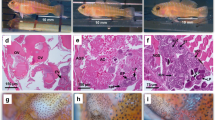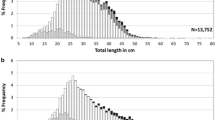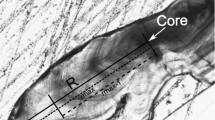Synopsis
Peters (1975) suggested the possibility of adult sex change in certain cichlids of Lake Malawi. When adultPseudotropheus lombardoi in male coloration were found mouthbrooding eggs under natural conditions in Lake Malawi, one of the possible explanations for this female-type behaviour was that sex change had occurred, but with the retention of male coloration. Behavioural investigations based on current models of social systems in sex-changing species were conducted in an attempt to substantiate this hypothesis. These observations were supplemented by an histological examination of the gonads of individuals of both sexes. A pronounced advantage in the mating success of dominant males over non-dominant males was noted. Similarly, large females had a greater reproductive success than smaller females. Thus, the possibility that sex change occurred inP. lombardoi following the ‘size advantage model’ (Warner 1975) was investigated. However, histological studies did not provide conclusive evidence of sex change; only undeveloped oocytes were found in the testes of all males examined. It is postulated that gonads of maleP. lombardoi pass through an intersexual juvenile period. Later, testicular elements dominate within a gonad still containing immature oocyte tissues. It is further suggested that femaleP. lombardoi are dimorphic, some having male coloration and others having female coloration.
Similar content being viewed by others
References cited
Aldenhoven, J.M. 1984. Different reproductive strategies in a sex-changing coral reef fishCentropyge bicolor (Pomacanthidae). Aust. J. Mar. Freshw. Res. 37: 353–360.
Baerends, G.P. & J.M. Baerends-van Roon. 1950. An introduction to the study of the ethology of cichlid fishes. Behaviour suppl. 1: 1–242.
Burgess, W.E. 1977.Pseudotropheus lombardoi, a new species of Lake Malawi Mbuna with reversed sexual coloration (Pisces: Cichlidae). T.F.H. Magazine 26: 63–67.
Charnov, E.L. 1982. The theory of sex allocation. Princeton University Press, Princeton. 355 pp.
Fishelson, L. 1970. Protogynous sex reversal in the fishAnthias squamipinnis (Teleostei, Anthiidae) regulated by the presence or absence of a male fish. Nature 227: 90–91.
Fischer, E.A. & C.W. Peterson. 1987. The evolution of sexual patterns in the seabasses. Bioscience 37: 482–488.
Fryer, G. & T.D. Iles. 1972. The cichlid fishes of the great lakes of Africa. Their biology and evolution. Oliver & Boyd, Edinburgh. 641 pp.
Ghiselin, M.T. 1969. The evolution of hermaphroditism among animals. Quart. Rev. Biol. 44: 189–208.
Holzberg, S. 1978. A field and laboratory study of the behavior and ecology ofPseudotropheus zebra (Boulenger), an endemic cichlid of Lake Malawi (Pisces: Cichlidae). Z. zool, Syst. Evol. — forsch. 16: 171–187.
McPherson, G.R. 1977. Sex change in the wrassePseudolabrus gymnogenis (Labridae). Aust. Zool. 19: 185–200.
Moyer, J.T. & A. Nakazano. 1978. Population structure, reproductive behavior and protogynous hermaphroditism in the angelfishCentropyge interruptus at Miyake-jima, Japan. Jap. J. Ichthyol. 25: 25–39.
Paterson, H.E. 1978. More evidence against speciation by reinforcement. S. Afr. J. Sci. 74: 369–371.
Peters, H.M. 1975. Hermaphroditism in cichlid fishes. pp. 228–235.In: R. Reinboth (ed.) Intersexuality in the Animal Kingdom. Springer-Verlag, Berlin.
Polder, J.J.W. 1971. On gonads and reproductive behaviour in the cichlid fishAequidens portalegrensis (Hensel). Neth. J. Zool. 21: 265–365.
Ribbink, A.J. 1975. A contribution to the understanding of the ethology of the cichlids of southern Africa. Ph.D. Thesis, Rhodes University, Grahamstown. 211 pp.
Ribbink, A.J., B.A. Marsh, A.C. Marsh, A.C. Ribbink & B.J. Sharp. 1983. A preliminary survey of the cichlid fishes of rocky habitats in Lake Malawi. S. Afr. J. Zool. 18: 149–310.
Sadovy, Y. & D.Y. Shapiro. 1987. Criteria for the diagnosis of hermaphroditism in fishes. Copeia 1987: 136–156.
Shapiro, D.Y. 1980. Serial female sex changes after simultaneous removal of males from social groups of a coral reef fish. Science 209: 1136–1137.
Shapiro, D.Y. 1988. Behavioral influences on gene structure and other new ideas concerning sex change in fishes. Env. Biol. Fish. 23: 283–297.
Shapiro, D.Y. & R. Lubbock. 1980. Group sex ratio and sex reversal. J. Theor. Biol. 82: 411–426.
Warner, R.R. 1975. The adaptive significance of sequential hermaphroditism in animals. Amer. Nat. 109: 61–82.
Warner, R.R. 1984. Mating behavior and hermaphroditism in coral reef fishes. Amer. Sci. 72: 128–136.
Warner, R.R. 1988a. Sex change in fishes: hypotheses, evidence, and objections. Env. Biol. Fish. 22: 81–90.
Warner, R.R. 1988b. Sex change and the Size-Advantage Model. Trends in Ecology and Evolution 3: 133–136.
Warner, R.R., D.R. Robertson & E.G. Leigh. 1975. Sex change and sexual selection. Science 190: 633–638.
Warner, R.R. & D.R. Robertson. 1978. Sexual patterns in the labroid fishes of the Western Caribbean: I. The wrasses (Labridae). Smithson. Contrib. Zool. 254: 1–27.
Wickler, W. 1962. Zur Stammesgeschichte funktionell korelierter Organ- und Verhaltensmerkmale: Ei-attrappen und Maulbrüten bei afrikanischen Cichliden. Z. Tierpsychol. 19: 129–164.
Wickler, W. 1963. Zur Klassifikation der Cichlidae, am Beispiel der GattungenTropheus, Petrochromis, Haplochromis undHemihaplochromis n. gen. (Pisces, Perciformes). Senckenberg. biol. 44: 83–96.
Zupanc, G.K.H. 1985. Fish and their behavior. Tetra Verlag, Melle. 188 pp.
Author information
Authors and Affiliations
Rights and permissions
About this article
Cite this article
Naish, KA., Ribbink, A.J. A preliminary investigation of sex change inPseudotropheus lombardoi (Pisces: Cichlidae). Environ Biol Fish 28, 285–294 (1990). https://doi.org/10.1007/BF00751042
Received:
Accepted:
Issue Date:
DOI: https://doi.org/10.1007/BF00751042




